
A Complete Guide to Local SEO for Healthcare
Here’s a bold claim: As a healthcare marketer, the easiest (and most effective) way to land more patients is through local search engine optimization.
The simple truth is that if you want to increase the number of people walking in your door, they have to find you first. And today, more and more people are finding the businesses they patronize through search engines.
By increasing your visibility on search engines, you’ll be opening the door to people who otherwise could never have found you. This simple but efficient tool is your key to improving your bottom line, and your gateway to taking your customer base to new heights.
And you’re in luck: We can help you do just that.
Why should you trust us? For over a decade, Wheelhouse has been successfully implementing local SEO strategy for a diverse portfolio of healthcare institutions.
Over the years, we’ve partnered with some of the biggest names in healthcare. From Fred Hutch to the Seattle Cancer Care Alliance to Providence, our work has been crucial to helping them navigate and master the ever-changing digital marketing landscape.
And the results themselves are astonishing. For one client, a healthcare network with more than 2,000 locations, our local SEO strategy drove to a 500% increase in both discovery search and total searches. For another, a regional healthcare system in the bay area, we secured a 1,600% increase in calls to schedule appointments — all while cutting cost-per-call in half.
How did we accomplish this? By taking a data-driven approach and putting in the work to really earn our clients’ trust. Our local SEO strategists are some of the best in the industry, and now, we’re excited to share what we’ve learned over our decade-plus working with healthcare clients.
In this guide, we’ll give you a rare look behind the curtain at how we’re able to drive our local wins. You’ll see it all: the framework we follow, the tools we use, and our thinking on which optimizations matter for you as a healthcare marketer. By the end, you’ll have everything you need to become a seasoned local SEO pro.
Without further ado, let’s get into it.
Section 1: Local SEO in a nutshell
What is local SEO? Definitions abound, but we’re partial to the one offered by Moz, which characterize it as the “practice of optimizing a business’s web presence for increased visibility in local and localized organic search engine results.”
In simpler words: Local SEO is Google’s attempt to prioritize local businesses in search.
That prioritization happens in a few ways. When Google recognizes local intent in a search query (i.e. they notice the query includes “near me,” or they pick up on a subtle phrasal clue that indicates locality), they’ll often serve a map pack.
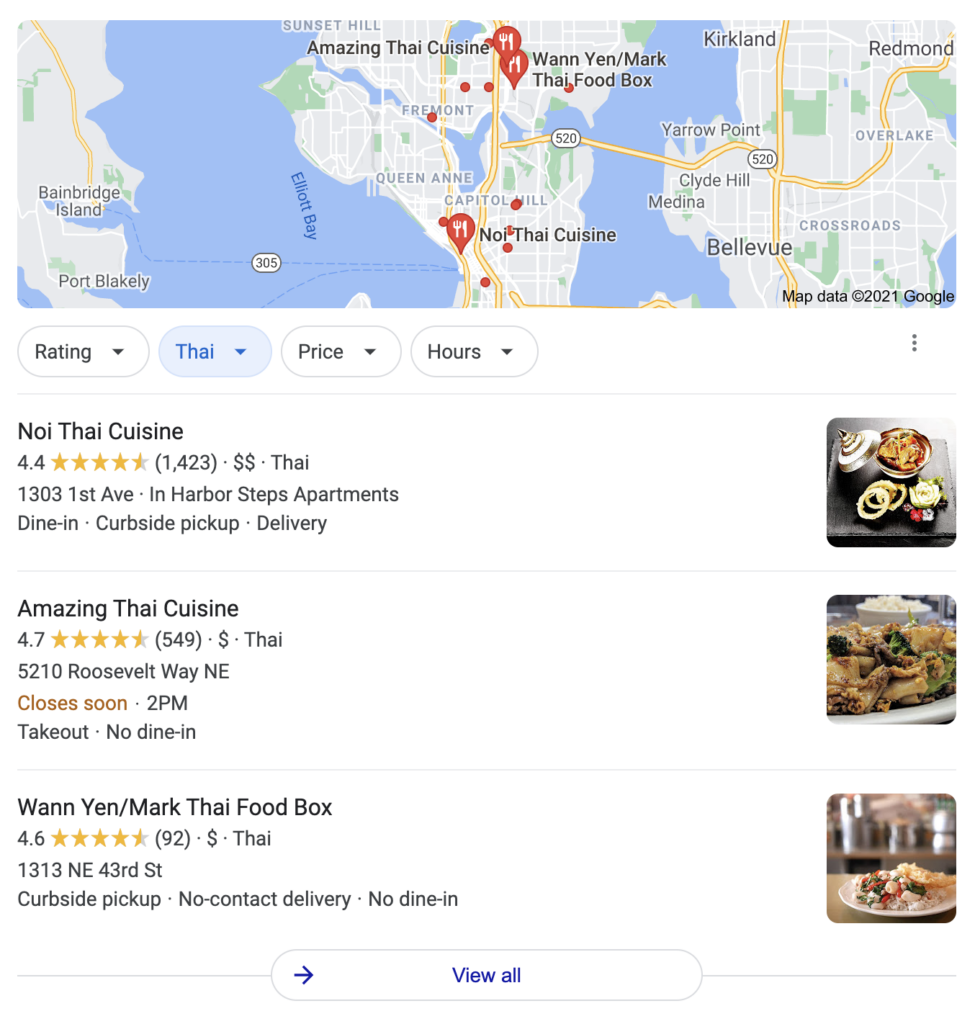
Map packs are three or more listings for a local business that appear above organic search in the search engine results page (also known as a SERP). They’ll appear above the organic results (and sometimes even above paid ads) when Google thinks the business’s services line up with what the searcher wants.
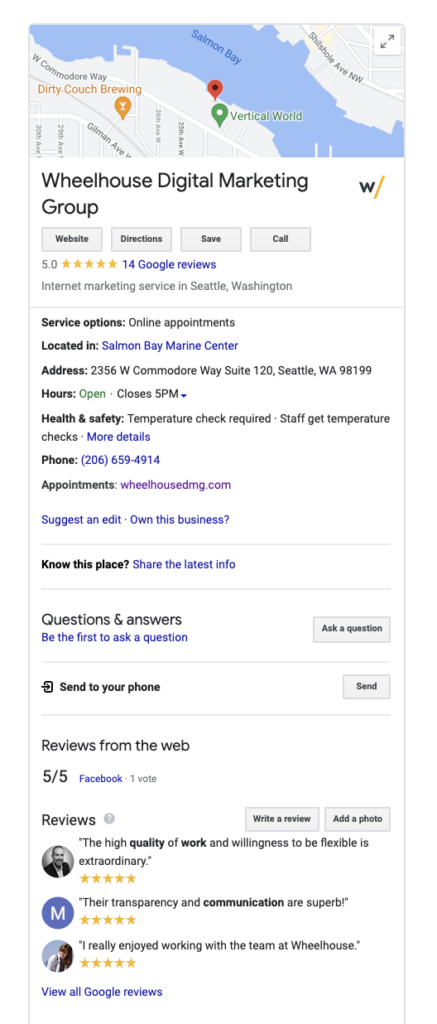
Another important local search feature is Google Business Profiles. These often appear on the right-hand side of the screen, and convey a business’s hours, addresses, phone numbers, ratings, reviews, and more.
[interrupt_download]
Local SEO vs. organic SEO
While Google’s local algorithm and organic algorithm are different, they work in largely the same way. Like online-only retailers, local businesses have to prove to Google that they’re prominent in relation to their competitors and relevant to the keywords in a search query. Only then will they be catapulted to the top of search.
Where the two disciplines differ is on the concept of proximity. When you search for something, Google knows what zip code you’re in (and if you’re searching on mobile, it can pinpoint you even more accurately). If Google recognizes local intent in your query, or if it decides that you can accomplish the task locally, it’ll connect you with a business in your immediate area.
That means in order to have success with local SEO, you have to convince Google your practice is prominent, your services are relevant, and you’re in close proximity to the searcher. We’ll look at each of these pillars individually later, but they’re the cornerstones upon which the foundations of local SEO are built.
Local SEO is on the rise
By all accounts, local SEO has only become more important in recent years. Around the end of 2018, we noticed a huge spike in local map packs for ecommerce-related searches… most of which didn’t have any local intent at all. Here’s what comes up when we search for “modern sofas” — a non-brand query that lacks any kind of local intent:
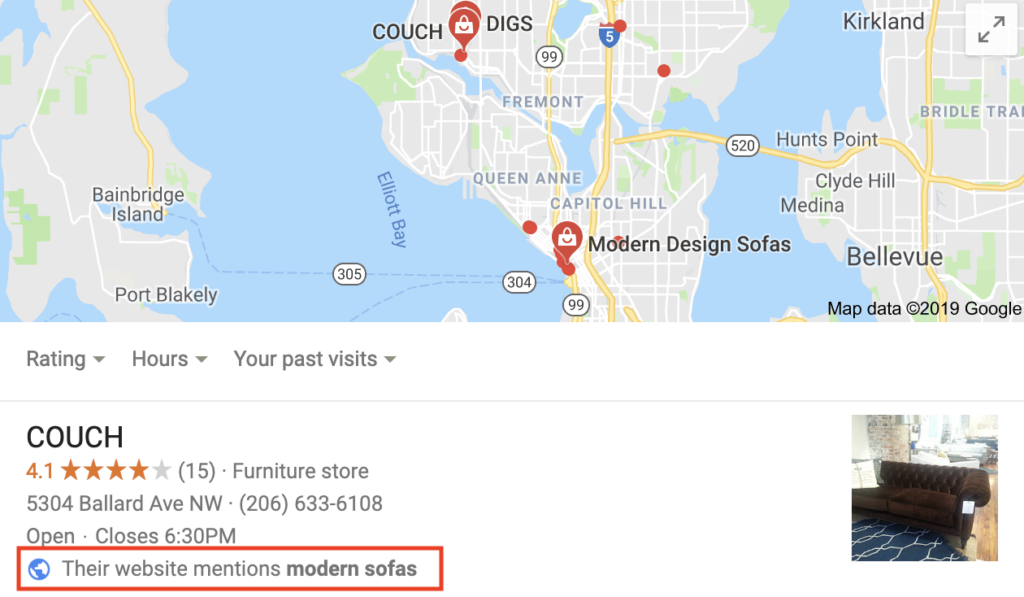
As you can see, Google’s trying to recommend a modern sofa retailer in my area. This indicates a big shift in their strategy toward prioritizing local businesses over big-box online retailers. It also means local search optimization is now a top priority for brick-and-mortar retailers looking to get more customers in the door.
Why did Google do this? Most likely because the demand for local is increasing (although even this claim is tricky… more info on that below), and Google’s algorithm had to reflect that. However, a second motive could’ve been to undermine Amazon’s dominance on organic searches for products.
In either case, the relatively new phenomenon of local SEO now figures prominently into Google’s SERPs. And it looks like it’s here to stay.
Still wondering how important a role it should play in your digital marketing strategy? Below, we’ll look at a few data points that convey why local SEO should be a top priority for businesses of all shapes and sizes.
Why is Local SEO important?
46% of all Google searchers are seeking local information. (Source)
Social Media Today reports that nearly half of all searches on Google are seeking local information. That’s a mind-boggling figure, even more so if you consider the fact that 97% of search engine users search online to find local businesses.
29% of all Google searches contain a local map pack (Source)
According to Backlinko, nearly a third of all searches pull up a local map pack. It’s hard to say for sure whether the demand for local results is really increasing, or if Google manufactured that demand by building it into their algorithm. In either case, we as marketers can do everything in our power to leverage it in our favor.
72% of consumers who did a local search visited a location within five miles. (Source)
When users search with local intent, how often do they end up going to one of the suggested establishments? According to HubSpot, they do nearly three quarters of the time when the business is within 5 miles. How many potential patients are within 5 miles of your practice?
As we can see, local SEO is most definitely on the rise, and Google has made a point of prioritizing local results on their SERPs. For healthcare marketers, the incentive to gain visibility on localized SERPs is greater than ever.
In the next section, we’ll look at local SEO in the context of healthcare organizations specifically.
Section 2: Local SEO and healthcare
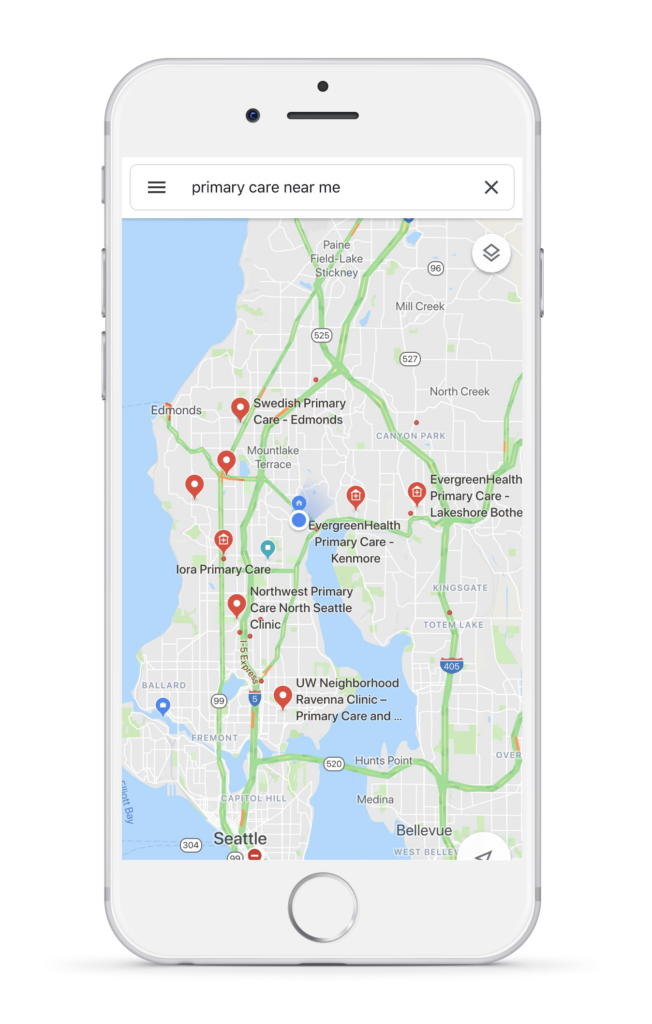
While every business can benefit from investing time and resources into their local SEO, it’s often not a top priority for healthcare marketers.
That’s because healthcare providers are, by definition, local. As brick-and-mortar institutions with a varied customer base and often a healthy dose of local competition, healthcare providers have a lot to gain by making sure they’re displayed prominently on Google’s results page.
Where old-school marketing campaigns and print/terrestrial advertising fall short, local search optimization can serve as an alternative entry point for patients coming into your practice. And if you’re wondering just how big an effect this could have on your bottom line, just know that local searches for primary care providers have been steadily growing over the past decade, with no sign of slowing:
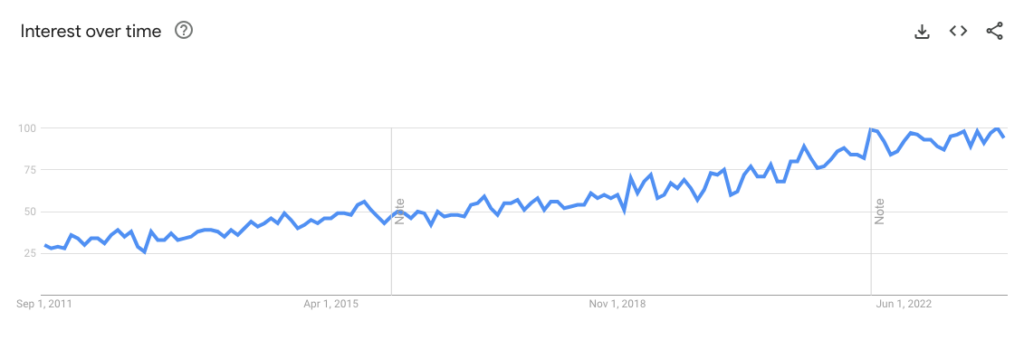
Booking an appointment: Turning prospective searchers into actual patients
Healthcare marketers’ biggest consideration when optimizing for search is typically how to make it as easy as possible to book an appointment.
Every time a searcher books an appointment, Google sees it as a user accomplishing a task. Google then rewards websites with high user task accomplishment rates, giving them better SERP placements and more overall visibility.
Google’s primary goal is to make it as easy as possible for users to accomplish tasks. That’s why, in April 2017, they added booking functionality to Google Business Profiles.
Now, users can book an appointment with a healthcare provider without ever leaving Google’s results page — which is great, if you’ve completed the optimizations detailed in section 4 and established yourself as a viable and trustworthy option. Once you do that, you’re well on your way to elevating your search presence and bringing more customers in your door.
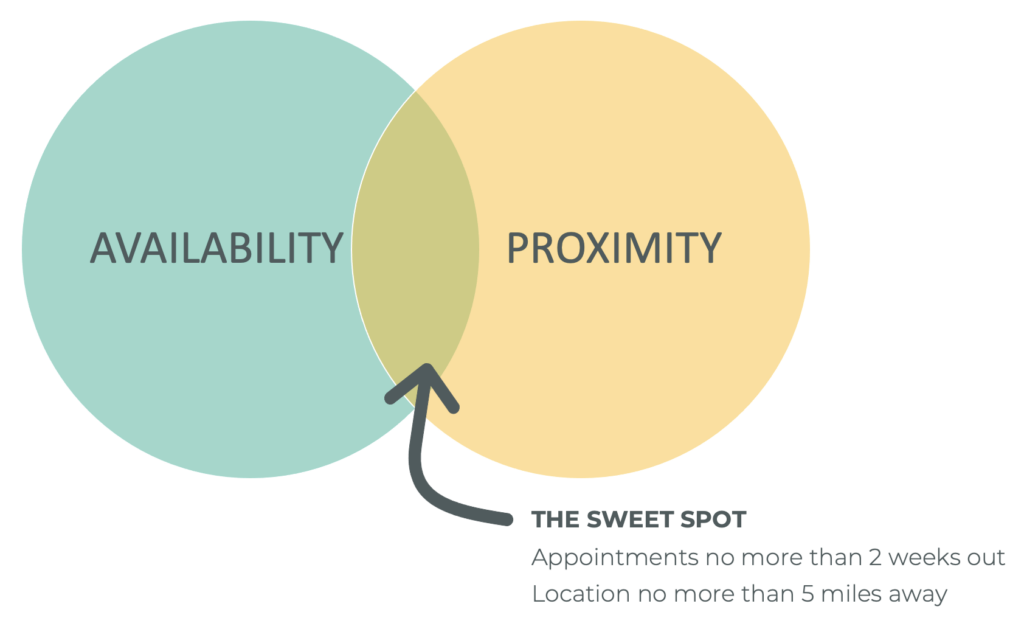
Availability & Proximity: Finding the sweet spot.
When it comes to online booking, there’s a sweet spot for healthcare-specific local SEO — and it centers around when and where users can get treated.
For the several thousand practices and physicians we’ve optimized for, we’ve found that Google is more likely to recommend providers who have appointments available no more than two weeks out, and no more than 5 miles away.
This means that users are looking for locations that have availability right now, and that are close to them, so they don’t have to travel.
It’s also important to note that that 5-mile radius can change. It can become smaller if you’re in a large metro area where there’s a lot of competition, or bigger if you’re in a more rural area, where you’ll be able to capture more of the market.
This means that when you’re optimizing for availability and proximity, you should consider the mix of healthcare providers in your area. If you’re in a highly competitive metropolitan area, you’ll likely have to try a little harder to make the cut.
What this all means for you
As a healthcare marketer, the above information is obviously very important as you shape your local SEO strategy. But how can you apply these principals to increase your local search visibility?
Since you aren’t able to physically move your brick-and-mortar practice (at least not easily), the biggest takeaway from all this hinges on availability. You should try your hardest to offer appointments no more than two weeks out — less than 1 week out would be even better.
Another takeaway: Add booking functionality to your Google Business Profile. For one of our clients, doing only this almost immediately resulted in a 40% increase in appointment bookings from local traffic. This is, without a doubt, one of the lowest-effort and highest-reward tactics you can do to improve your practice’s local SEO basically overnight.
And finally, if you are thinking of expanding to a second, third, or even a fourth location, do so with local SEO at top of mind. Aim to cater to communities where you think you have a shot at competing in search (for example, it may not be the best idea to set up shop next door to your region’s leading medical provider for your specialty).
In the next section, we’ll walk you through how to add booking functionality to your Google Business Profile listing, as well as other tips to help your local practice prosper. [interrupt_download]
Section 3: Using Google Business Profiles to leap to the top of search
Your Google Business Profile is to local SEO what a phone number was to the yellow pages. It’s the easiest way for people to find you, and it’s a crucial step when deploying a location-based digital marketing strategy.
At its core, Google Business Profile (or GBP for short) is a free tool from Google that lets business owners manage their online presence. You can edit things like addresses, phone numbers, hours, photos, and much, much more.
With localized search results and map-based SERP features appearing more frequently in Google results, your Google Business Profile has become the virtual face of your business. You should devote time and resources to making sure it stands out, and it should be highly optimized so that Google recommends it to as many people as possible.
Below, we’ll walk you through how you can optimize your Google Business Profile to encourage more local traffic toward your practice.
(It’s also important to note that GBP is specific only to Google, so your info won’t be updated on other search engines. We only focus on Google here because it’s far and away the most popular search engine — but check section 5 for tools that will let you apply these principles other search engines and directories.)
Section 4: How to make a great Google Business Profile
1. Keep a high profile.
Confirm, claim, or create profiles on GBP and other key platforms.
Create a listing for every location and physician in your system. If you want to cover all your bases, do this for other platforms beyond Google Business Profile — Yelp, Facebook, Bing, Apple Maps, Safari, Mapquest, etc. are all good options.
2. Take your NAP.
Make sure your name, address and phone number are accurate.
Once you’ve claimed your listings and confirmed they’re ready to go, make sure all your basic information is accurate and up to date. Consistency across listings is incredibly important for helping searchers find you, and if you’re confident in your coding abilities, you can use Local Business Schema to identify NAP information on your site and make sure Google’s displaying the right information.
3. Dress for success.
Add attractive photos, accurate descriptions, and other meaningful profile content.
Now it’s time to dress your profile up a bit to make it stand out. Add beautiful photos, detailed descriptions, and generally good content to make it pop in a sea on barebones listings. If necessary, hire a photographer and a copywriter to really make it shine.
4. Be an all star
Leverage GBP’s advanced features to build out your profile.
Google Business Profile has a host of optional features for users who’d like to stuff as much information as possible into their listings, and we recommend you make use of them. Add additional information like parking availability, service/insurance menus, optimized descriptions, primary/secondary categories, and more to help searchers get the information they need at a glance.
5. Plan to dominate.
Identify opportunities for localized content, review solicitation and response, and local link building and citations.
In reality, local listing optimization is just the start. You should take a moment here to plan your next moves. Writing localized content is a great way to target local keywords and earn more organic visitors — not to mention an awesome opportunity to demonstrate your deep knowledge of your community. Review solicitation (detailed in section 4) is another great way to generate more engagement, and consider utilizing GBP’s post feature to highlight upcoming events, new/updated services, and other content.
6. Book it!
Link booking to listings.
Perhaps most importantly: Remember to add booking functionality to your listing! Adding a scheduling link reduces friction and is an easy, effective way to get more patients in your door today. You can link directly to single physician or a whole practice, and consider adding on-site modals that shorten the overall appointment booking process.
A note on reviews
Your Google Business Profile is also where your reviews are located. Reviews allow patrons to directly rate your services on a scale of 1-5, as well as leave a comment. A good review or rating can mean more clicks and more people in the door; a bad one can mean the opposite.
Reviews and ratings are the number one deciding factor when a customer is deciding which local business to patronize. They’re also the factor you have the least control over.
We understand that this can be scary, and oftentimes it puts people off local optimization altogether. But remember, the best defense is a good offense.
By encouraging reviews from patients, responding to negative reviews, and incorporating a review management tool into your SEO strategy, you’ll be doing more than most businesses to make sure your digital reputation stays pristine.
Follow our best practices for GBP reviews outlined in the next section, as well as the review management tools in section 5, to ensure you’re leading your listing with your best foot forward.
Businesses of all kinds should try their hardest to get ahead of their reviews and ratings. The easiest way to do this is by soliciting reviews from happy customers.
Tools like BrightLocal give you a template to reach out and ask for a positive review, either via SMS or email. You can also make the ask in person when they’re on their way out — say it only takes a second and it makes a world of difference for your practice.
Make sure your customer service is A1.
Once the reviews start rolling in, respond to them professionally. Thank positive reviewers for their kind words and say that you look forward to seeing them again. Tell unfavorable reviewers that you appreciate the feedback, and you’ll address it prior to their next visit.
Get all your basic SEO housekeeping in order.
All the basic SEO best practices you’ve heard about are also important for localized SEO. That means your Title tags, metadata, alt tags, H1s and H2s, anchor text links, etc. should all be used correctly, and you should try to employ your target keywords whenever possible. (But not too often.)
Make sure all your pages are well linked.
Having well-linked pages makes it easier for Google to see and understand your website, which in turn makes it easier for people to find. Try to make each page link not only to your home page, but to other related pages as well, and make sure you anchor your text on accurate keywords.
Optimize for mobile.
Over half of all Google searches take place on a mobile device. Your website should be optimized for their screens, so there’s a seamless experience wherever they choose to book an appointment. If you scare them away with a bad UI experience, they may never return.
Optimize for voice search.
Between Google Home, Amazon Echo, and Google Assistant, Siri, and more, 40% of internet users in the U.S. use voice search. What’s more, voice searches are three times more likely to have local intent than their text-based alternatives.
Use that to your advantage by making it easy to voice search for your business, and weave local keywords (like city name, neighborhood names, regional slang, and other local color) consistently throughout your website.
Add a virtual tour.
Virtual tours give people the impression they’re stepping foot in your building, and they’re a great addition to your Google Business Profile. People love interactive content, and they’ll appreciate the option to scope out your front offices with immersive, 360-degree imagery. (Google also loves recommending this view to people).
Make local content.
One of the best ways to draw local users in is to make content that appeals to them on a local level. Dedicate a section of your site to writing about local news, industry events, and new hires. This top-of-the-funnel content will go a long way in bringing in eyes that otherwise would’ve gone elsewhere.
Make location pages for each individual office and physician.
This is an easy one: For each location and every physician, create a new page on your website. Location pages should contain an address, hours, and maybe a list of staff.
For physicians, it should include a small bio and a list of their accreditations, along with any awards they may have received. For each, feel free to throw in a few testimonials (handily sourced from the “reviews” section of your listing) for good measure.
Think of each best practice listed above as a kind of building block in the mile-high skyrise that is your SEO strategy. On their own, they’re helpful, but not anywhere near as supportive as they are when they’re all used together.
At Wheelhouse, we take a top-down, holistic review of your SEO strategy and go from there. It can be easy for any of the above practices to end up in a silo (say, for example, that your dev team isn’t in lockstep with the marketing people handling your reviews).
Our approach to digital marketing hinges on one word: unison. We want to make sure every single optimization compliments one another, and that each piece of the puzzle fits together just so. That way, the final product is as cohesive and intuitive as can be.
But to truly compete in the competitive world that is local SEO for healthcare providers, you’ll need some assistance. In the next section, we’ll look at some tools that help us achieve astonishing results for our clients.
Section 5: Tools of the trade
When it comes time to deploy and monitor your local SEO strategy, you can pretty easily eliminate redundancy and increase efficiency with any number of digital marketing tools.
Through every step of the process, from competitive analysis to keyword research to analytics monitoring, there’s a tool that will not only streamline it, but in some cases even add value you couldn’t have found otherwise.
That being said, there may even be too many good local SEO tools out there. So how do you know which one will be right for you?
That’s the question we’ll aim to answer in this section. Follow along as we break down what makes a great local SEO tool, and listen as we key you in on which ones take the cake.
Why can’t I just manage my listings manually?
This is a great question most beginners have. The answer is: You can! But you’ll be limiting yourself.
The problem with manually managing your listings is that you’re working solely within Google’s platform. For some people that’s fine — after all, Google is far and away the most popular search engine. But if you want to cover all your bases, it’s simply not enough.
Using a third-party local SEO tool can open the door to any number of platforms outside the framework of Google. Apple Maps, Bing, Mapquest, and more — these are all great sources of traffic that you’d be missing if you stuck solely with Google.
You could try to manually update your listings on all those platforms individually, but the project would be tedious and prone to errors. Local SEO tools grant you the ability to make sure all your data is accurate and up to date across platforms, and they take the long, arduous hours out of the equation.
What makes a great local SEO tool?
In our minds, a good SEO tool should do two things: 1. It should take the tedium out of your work, and 2. it should make your strategy easier to formulate and scale.
Another mark of a good tool is its age. Has it been around for a while? If so, then it may have reached a kind of maturity, and you can rest easy knowing most of the bugs have likely been sorted out by now.
But enough small talk. Which tools are the all-around winners in our eyes?
Below, we’ve done the work for you and compiled a list of our favorite tools for local SEO. For each one, we’ll give you some high-level notes, so you can decide which are best suited for your practice and your goals.
Listing and review management tools
BrightLocal
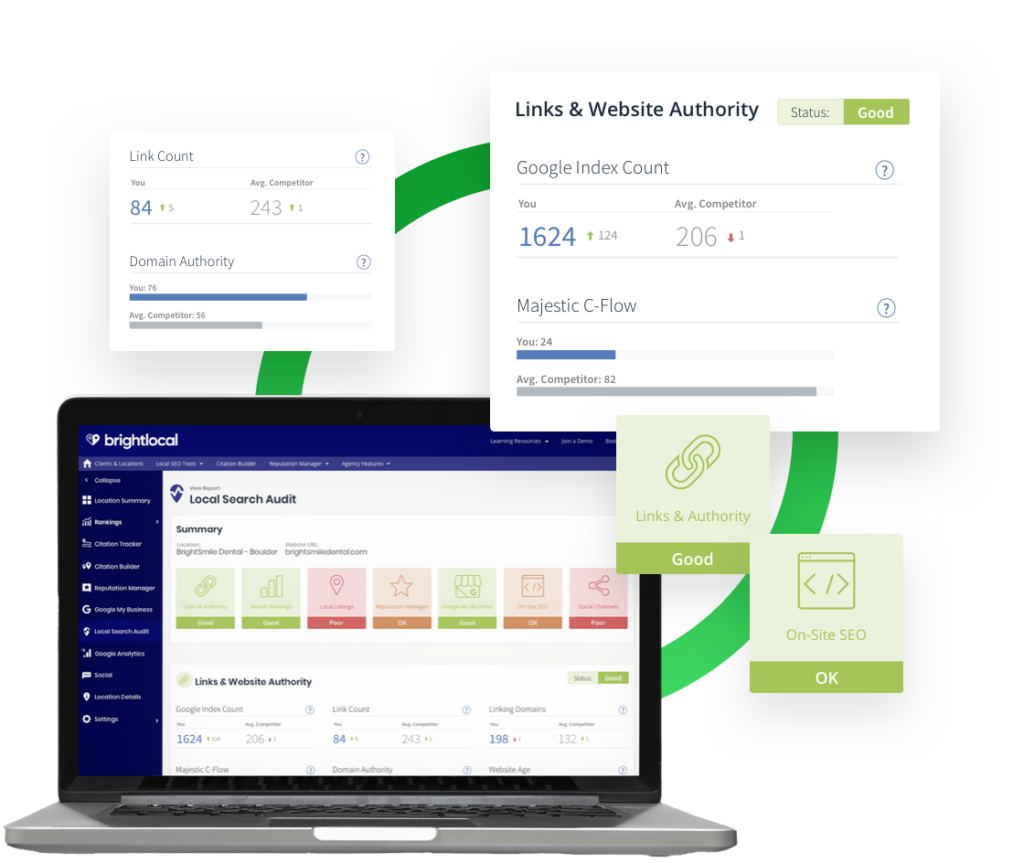
BrightLocal is a local SEO management and reporting tool that lets you track your rankings, manage reviews, and build citations all in one place.
It’s an extremely versatile tool that has a lot going for it. The citation builder helps you keep all your listings up to date and consistent across platforms, and the review manager provides you with a template to solicit positive reviews from happy customers.
Sure, the automation is lacking, and reports can be slow to run, but for most small- to medium-sized practices, the pros should significantly outweigh the cons.
It’s easy to see why BrightLocal is so popular — it’s an easy way to expand your business and earn a 5-star reputation.
Moz Local
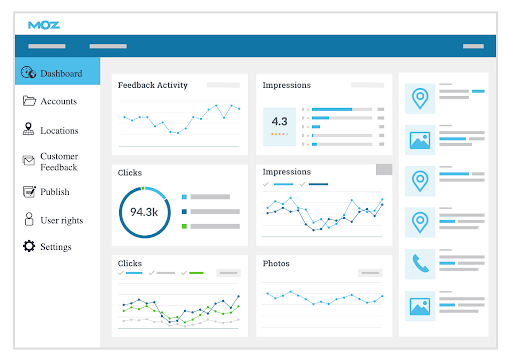
Moz Local is a tier up from its most direct competitor, BrightLocal (listed above).
Basically, Moz Local does everything BrightLocal does, with the added benefit of advanced automation functionality. That means you can do all the same things at scale, making it perfect for bigger operations who may have outgrown BrightLocal, or those who want to automate most of their management processes from the start.
Naturally, it’s more expensive than BrightLocal, but it’s a great option for those looking for an elegant all-in-one local SEO tool — and it makes even more sense if you use it in tandem with other Moz tools.
Yext
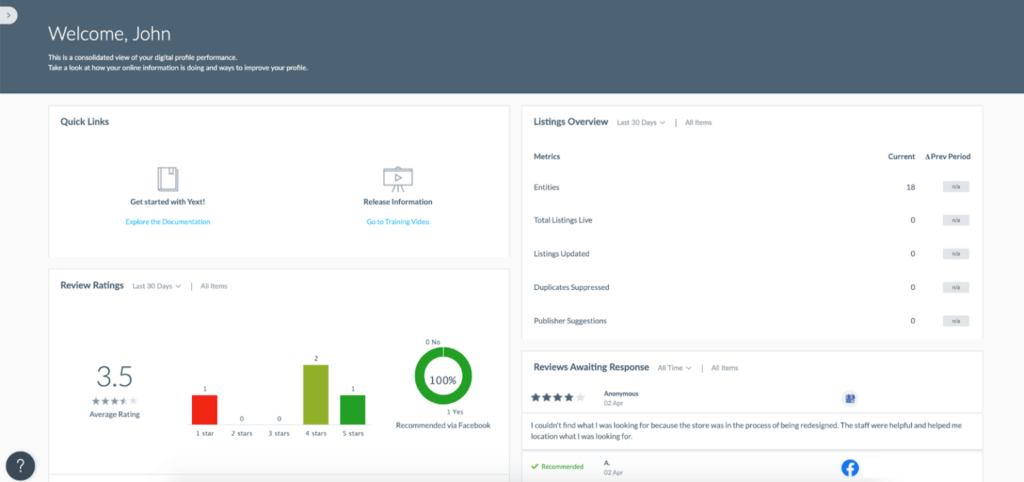
Yext is the enterprise alternative to the two tools listed above. It’s probably got more features than necessary for most small- to medium-sized businesses, but large healthcare providers or regional healthcare systems will appreciate its adaptive and diverse skillset.
Yext’s two biggest selling points are automation and customizability. The automation is greater even than Moz Local’s, so it can take the wheel for even more management processes.
Beyond that, the review monitoring and notification system lets you automatically respond to negative reviews, and an AI-driven feature audits each review’s sentiment.
Note that Yext is primarily for large-scale businesses, so it may be harder for beginner marketers to navigate. If you find yourself struggling to make use of all its advanced features, reach out and we can schedule a consultation.
Keyword research, ranking, and competitive analysis tools
LocalFalcon
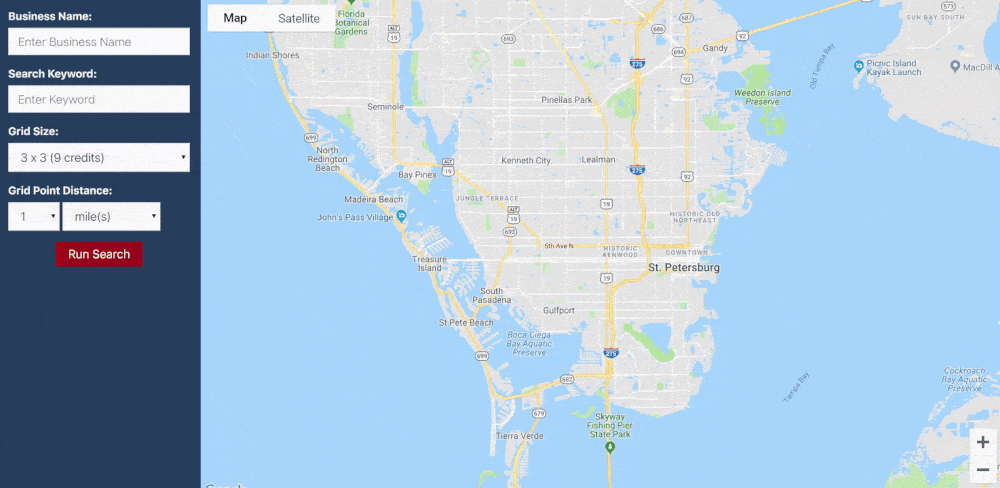
LocalFalcon is a hyper-local SEO tool that overlays real-life ranking data on a map-like grid.
This way, you can see who’s ranking for what keywords in which areas — and know exactly who your immediate competitors are, as well as how you stack up.
That information can be incredibly valuable to you as digital marketer. It can guide optimizations, evaluate how well those optimizations performed, and help you grow your business beyond your immediate neighborhood.
LocalFalcon’s pricing is also flexible (ranging from $24 to $199 per month), so you can get what you need without overpaying for superfluous bells and whistles.
Perhaps the only downside of LocalFalcon is that it’s not a one-stop-shop for all your local SEO needs. In order to successfully rank for competitive keywords, you’ll need to know which terms you should be targeting. That’s where the next tool comes in handy.
Keywordtool.io
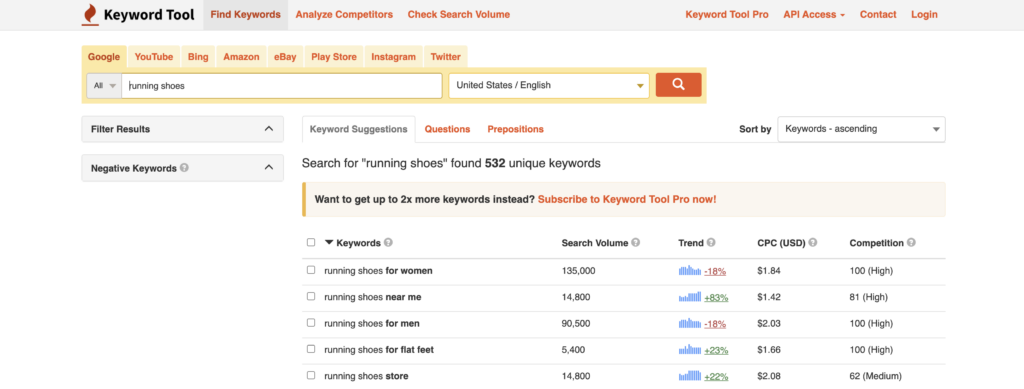
Keywordtool.io is a keyword research tool that offers localized keyword research with data specific to Google, Amazon, YouTube, eBay, Instagram, and more.
You don’t need an existing local listing to get started, which means this tool is perfect for smaller practices looking to dip their toe into local SEO. Perhaps the biggest value it delivers is its “related keywords” feature, so you can see what other keywords you have a shot at ranking for in your community.
This tool is (relatively) cheap, accurate, versatile, easy to use. What more could you ask for?
Other tools
Google Analytics and Google Search Console
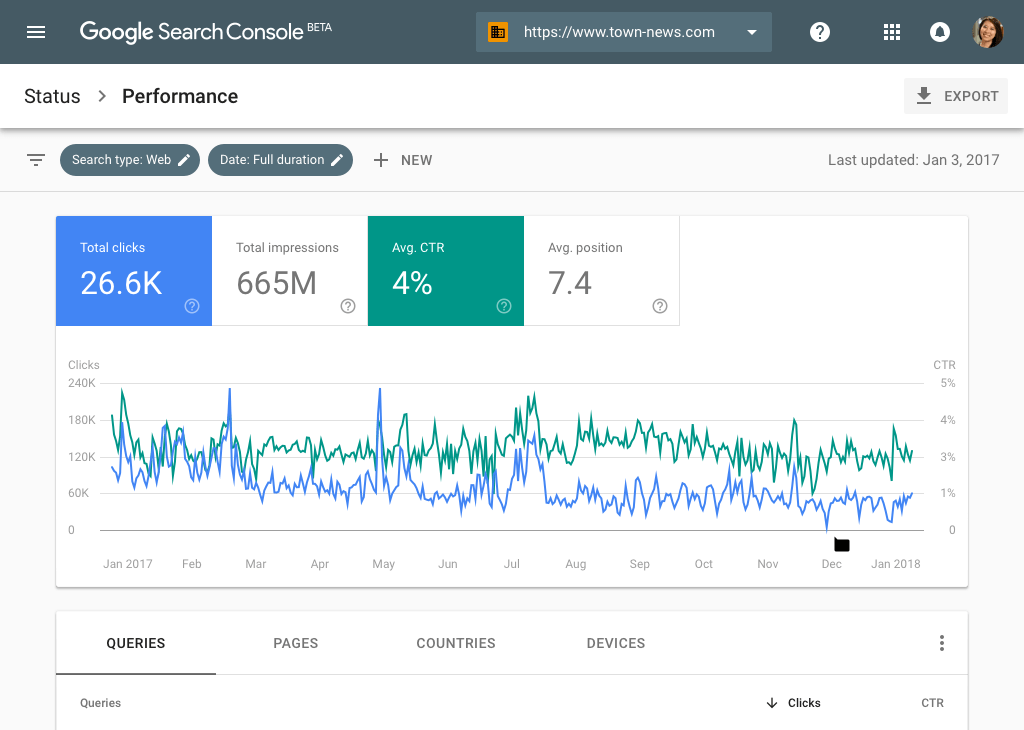
Google Analytics and Google Search Console are two free tools from Google that allow you to track user behavior and improve your overall SEO game. Quite simply, they’re a must-have for a business with any kind of online presence whatsoever.
Google Analytics is likely the most-used analytics platform on the planet, acting as a kind of jumping off point for marketers of all stripes.
Google Search Console is more of a search data tool. It provides valuable insights on things like position and click-through-rate so you can adjust your strategy accordingly. What’s more, GSC can evaluate your site’s technical health, meaning you can rest easy knowing no errors are harming your rankings.
While both these tools are powerful on their own, they’re particularly mighty when employed in unison. We recommend them to businesses of all sizes, but they can be especially useful for a smaller practice looking to get its foot in the door of digital marketing.
Coming up next, we’ll see how those tools can be used effectively, as we look at some of our favorite examples of local SEO done exceptionally well.[interrupt_download]
Section 6: Examples and case studies
If the best way to learn is by doing, the best way to improve is by studying those who have done it well.
Luckily for us, there’s no shortage of great local SEO examples out in the wild. Across practices, fields, and industries, there are people pouring their heart and soul into the work, making sure others have access to the businesses in their immediate community.
In this section, we’ll break down some of our favorite healthcare-specific examples and talk a bit about why they work so well.
Example: UW Medicine
UW Medicine’s Ballard Clinic Page
UW Medicine does a great job of tailoring its locations pages to maximize their local visibility.
Each of their locations has a robust, optimized landing page with no shortage of helpful content and local keywords. Let’s break it down piece by piece.
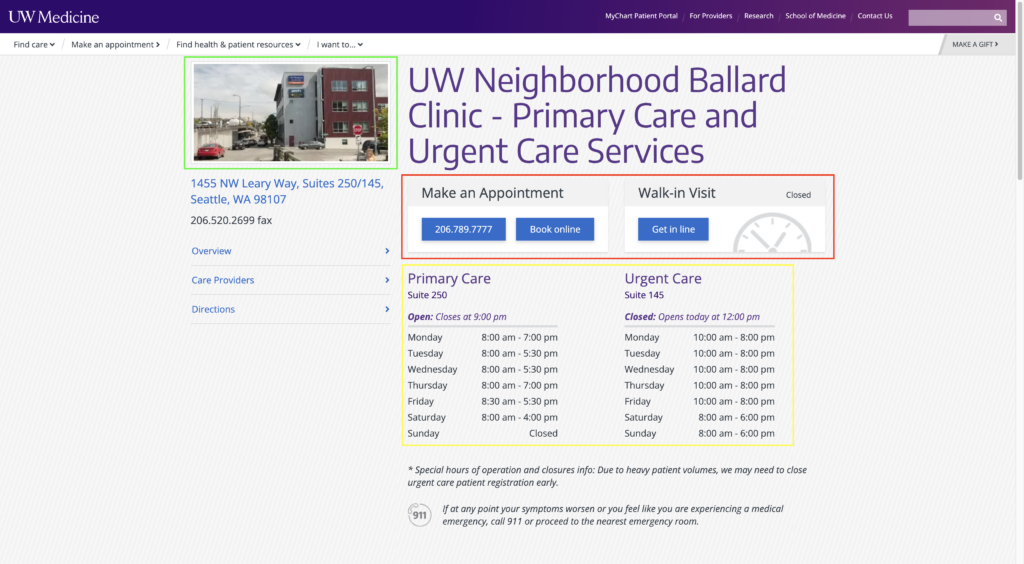
The first thing you see when you land on UW Medicine’s location page is a street image of its facade (highlighted in green). Real-life, location-specific photography should always be used for location-specific pages, as it helps visitors find your practice and lets them know what to expect upon entering.
Next, users can place a phone call, book an appointment, or get in line for a walk-in visit (highlighted in red). This is usually a searcher’s primary goal, and placing it right up top helps them accomplish it quickly.
The “book online” function opens a prepared module that guides users through the booking process from beginning to end:
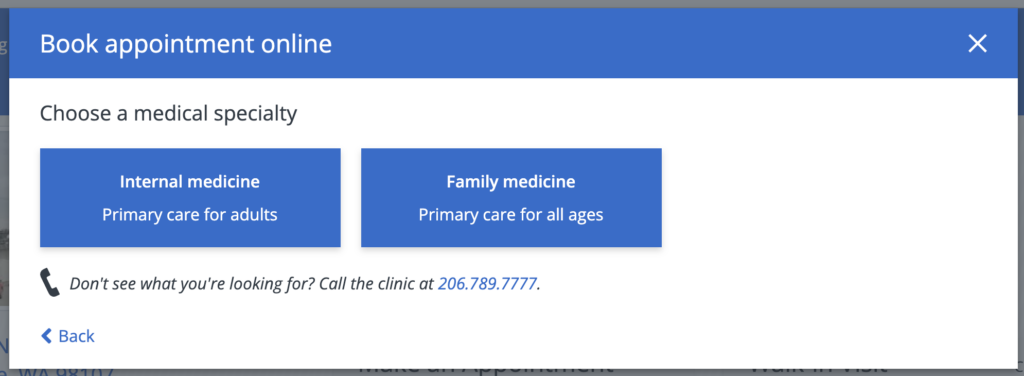
At Wheelhouse, we’ve built on-site booking modules for clients that have directly led to a 515% increase in online appointment bookings.
Next, the hours (highlighted in yellow) are prominently displayed below the booking functionality. Another important piece of important information for searchers, it’s right at home at the top of the page, solidly above the fold.
Now let’s look at the below-the-fold content:
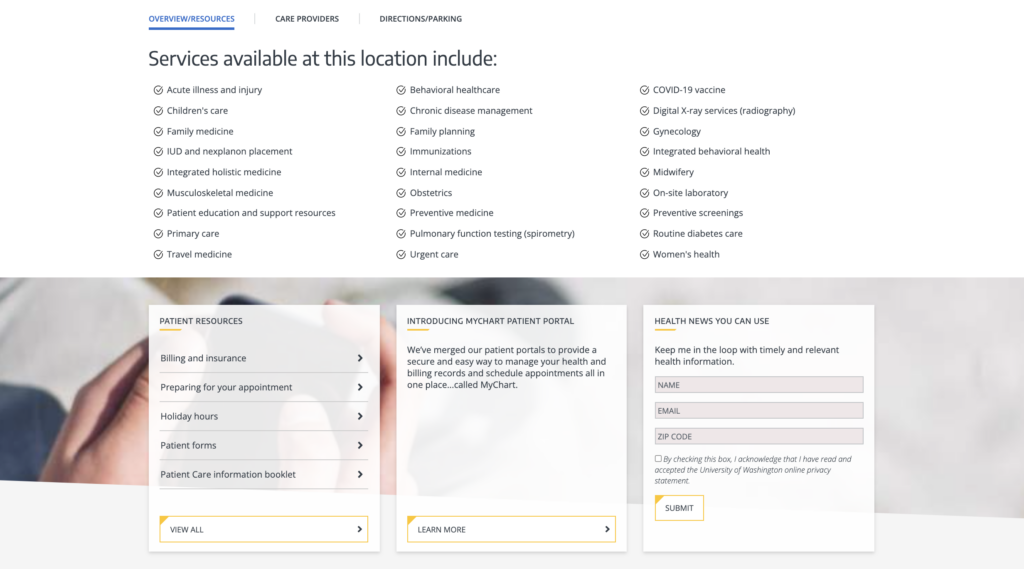
First up is an overview of services available at this practice. While this is primarily for patients who are looking for this information, it’s also great keyword targeting.
When someone searches “obstetrics near me,” this piece of the puzzle lets Google know that this specific location does provide that service, making it more likely to recommend the page (sometimes with the tagline “Their website mentions obstetrics“).
Below that is more information for searchers and Google to pull from. “Patient resources” is an FAQ in the form of a network of hyperlinks, and is very helpful to searchers looking for __ on everything from insurance to appointment booking to holiday hours; the patient portal links out to UW Medical’s all-in-one user interface; and the newsletter is an exceptional resource for those looking to stay updated with changes and general goings on on at the practice.
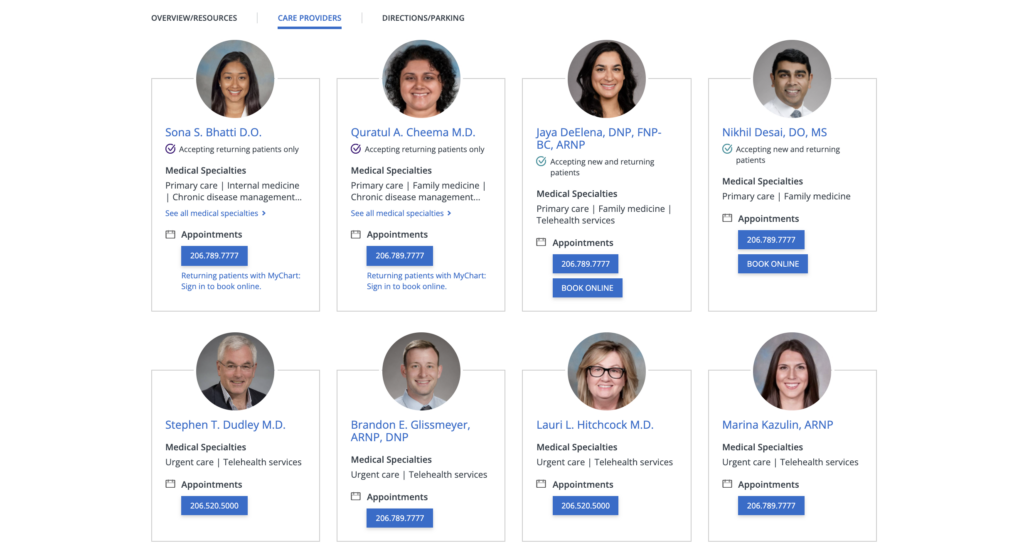
Up next is a carousel of doctors, along with their booking availability and an overview of their specialties. A phone number makes it easy for new and returning patients to contact them and schedule an appointment directly.
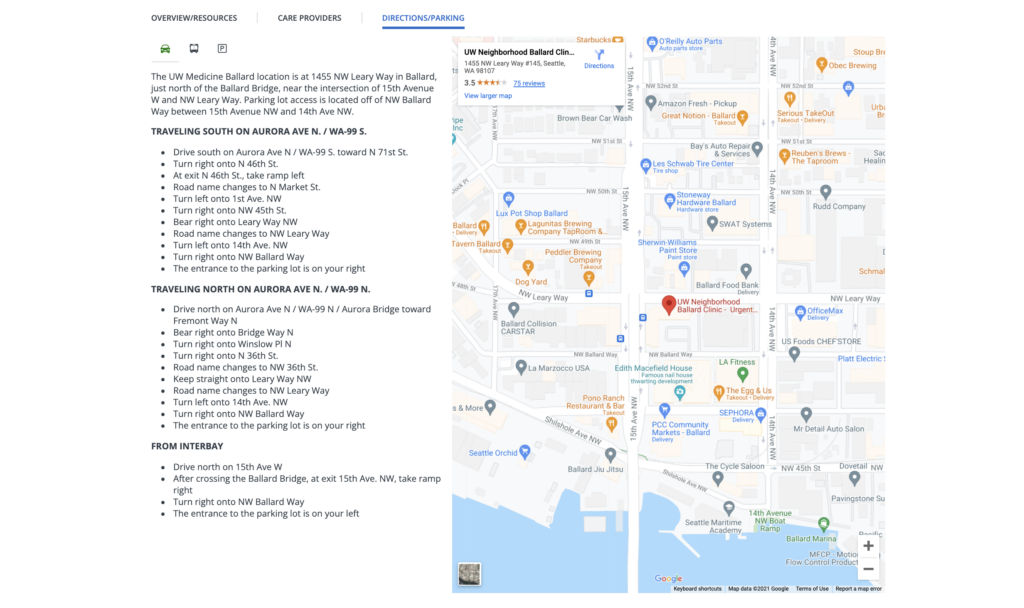
A map and parking directions ensure patients are able to find their way to the practice, and park when they arrive. Bus routes are also available for those who don’t drive, and free parking is mentioned under the “parking” tab.
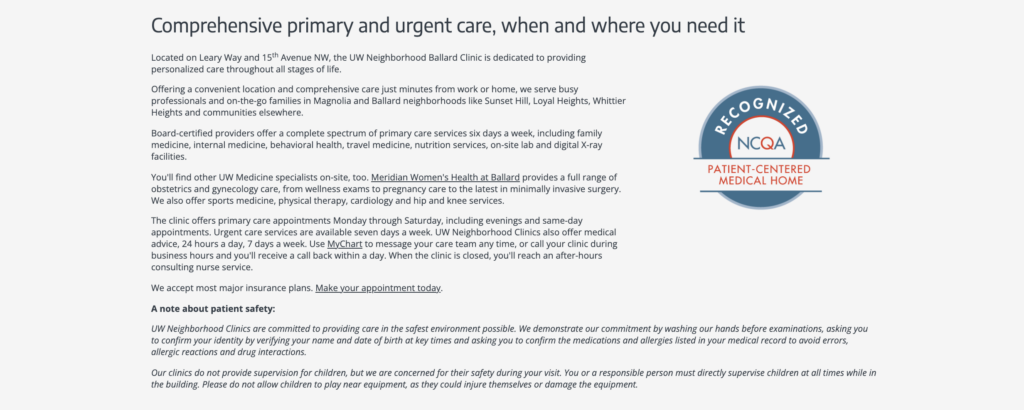
Finally, a great big piece of localized content rounds out the page. Notice that it doesn’t just mention the principal neighborhood (Ballard), it also mentions several neighboring communities (Sunset Hill, Loyal Heights, Whittier Heights, etc.). That way, people making hyper-local searches like “primary care Loyal Heights” have a shot at finding this page.
UW Medicine is one of the leading healthcare networks in the Seattle metro area for a reason. Their local SEO efforts are well thought out and varied — you can tell just by looking at their site. Other practices, no matter the size, can learn a lot just by spending some time with it.
Case Study: Providence
Here at Wheelhouse, one of our biggest local SEO wins came when we partnered with Providence, the second-largest healthcare provider in the U.S.
Providence asked us to develop and implement a whole new local SEO strategy from scratch. When we began, they had no local SEO ecosystem, no consistency with regard to Google Business Profile management, and no way of tracking or evaluating their performance. We established two main goals: to boost search visibility and increase appointment bookings.
We started small, zeroing in on a few primary care providers and urgent care locations in the Seattle metro area. After claiming the GBP listings for each location, we worked with the providers to fully optimize their profiles.
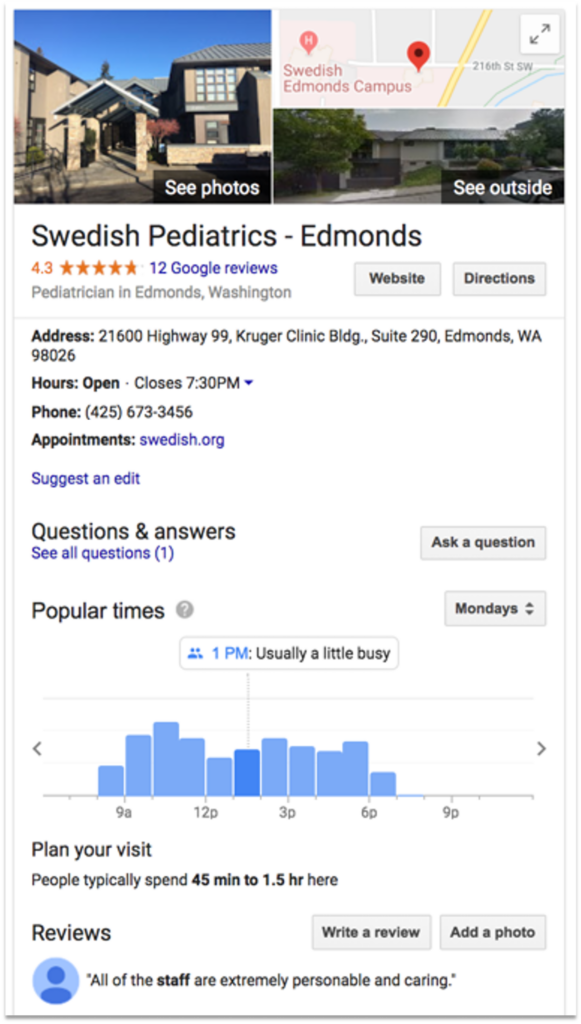
Taking a page from section 3 of this guide, we made sure all the NAP data was correct, added pictures and descriptions, and optimized business categories. Most importantly, we leveraged the then-brand-new “appointment booking” feature to introduce booking functionality to their GBP listings.
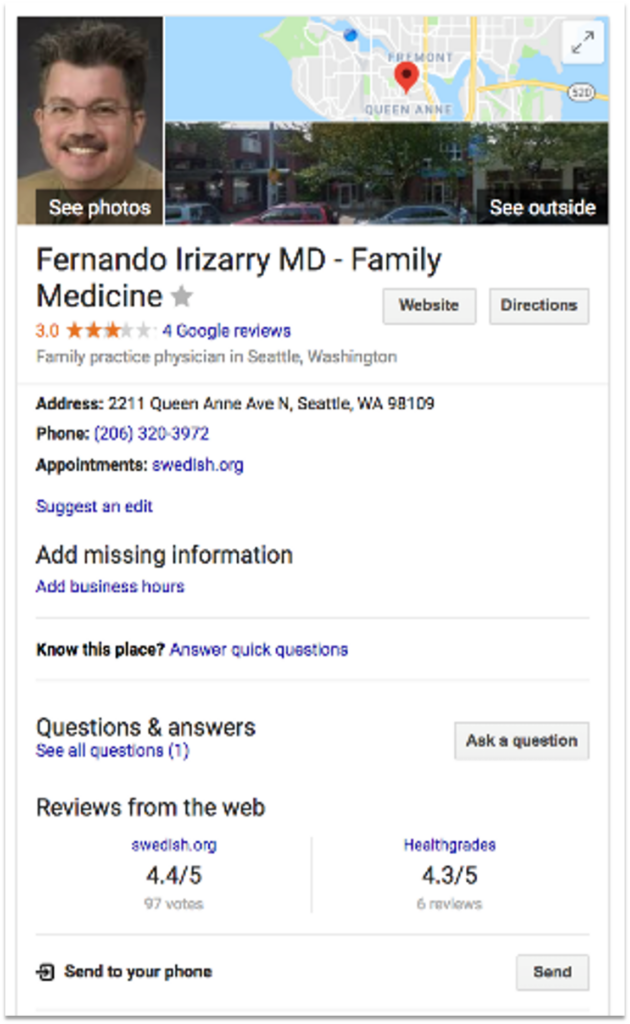
All of this served as an attempt to reduce friction and shorten the distance between searching for a provider and scheduling an appointment. We wanted to make it as easy as possible for users to find them in search, and try to increase their visibility in a highly competitive metropolitan area.
Our efforts paid off. Within 6 months, nearly a third of all appointment bookings came from a local listing. Before our campaign began, that number had been less than 1%. Beyond that, discovery searches were up 47%, website clicks were up 44%, and phone calls were up 38%.
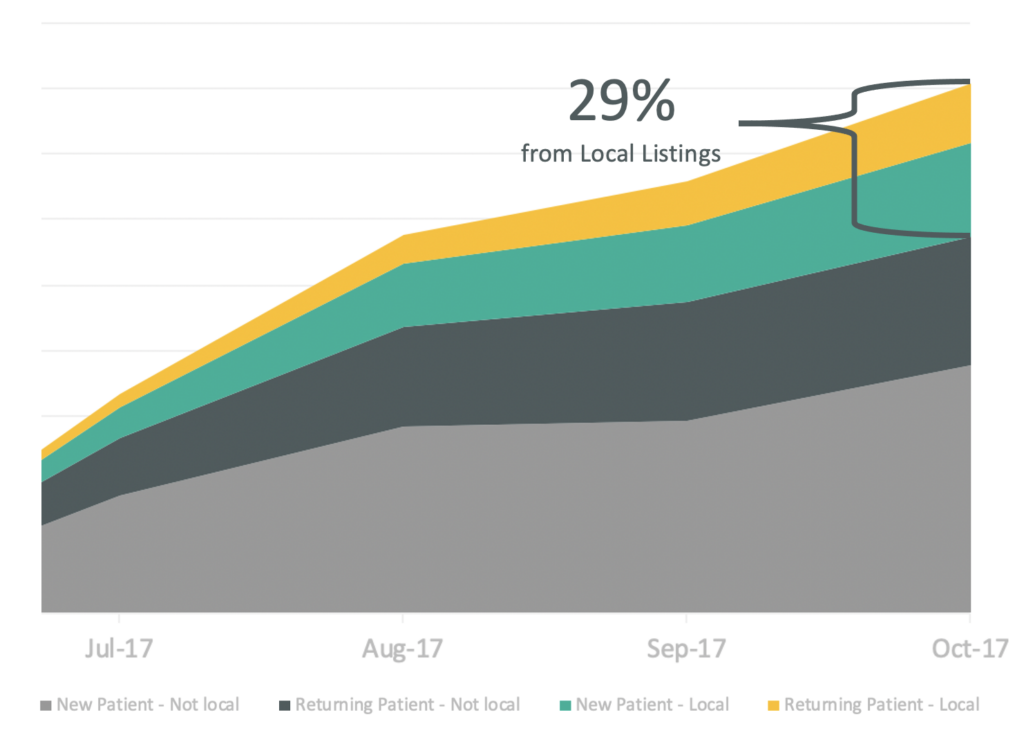
Those analytics made it clear: By optimizing and shoring up consistency across listings, we could create very significant incremental growth that would have real-life effects on Providence St. Joseph’s bottom line.
Using that small pool of providers as a test case, we scaled our efforts to over 2,000 locations across the western U.S. During this push, we paired our listing optimizations with landing page redesigns that improved the conversion funnel to maximize the value of our now-surging local traffic.
The cumulative effect of our campaign was astounding. Our listing optimizations across over 2,000 locations led directly to an 806% increase in online appointment bookings. As far as visibility goes, we were able to increase both discovery searches and total searches by 500%.
While this was a huge effort on our part that spanned many months, it’s important to note that these same strategies can drive similar successes on much smaller scales. Local listing optimizations can have as great an effect on a single small practice as it did on Providence’s sprawling network of providers. By putting in the time and effort, you too can substantially increase your search visibility and revitalize your practice.
Epilogue: We’re here to help
Behind every great practice there’s a phenomenal local SEO wizard, pulling all the right levers to increase search visibility and get more patients in the door.
Maybe you have one at your practice. Maybe you don’t. In either case, we can help.
We’ve partnered with healthcare organizations of all shapes and sizes to deliver results that went above and beyond our wildest expectations. Whether it’s for a multinational healthcare network or a small mom and pop practice, we’ve partnered with our clients to make lasting improvements to their SEO.
Our services go beyond local SEO to cover everything from digital strategy to paid advertising to full-stack engineering. We’ve even built our own proprietary technology to provide value that literally no other agency on Earth can deliver.
Our 3 core principles — helpfulness, generosity, and joyfulness — guide us every step of the way. We end each day grateful for the work we got to do, and proud of the wins we were able to deliver to our clients.
Are you looking to kickstart local SEO efforts at your practice? Give us a call. We look forward to helping your practice realize its full potential.


